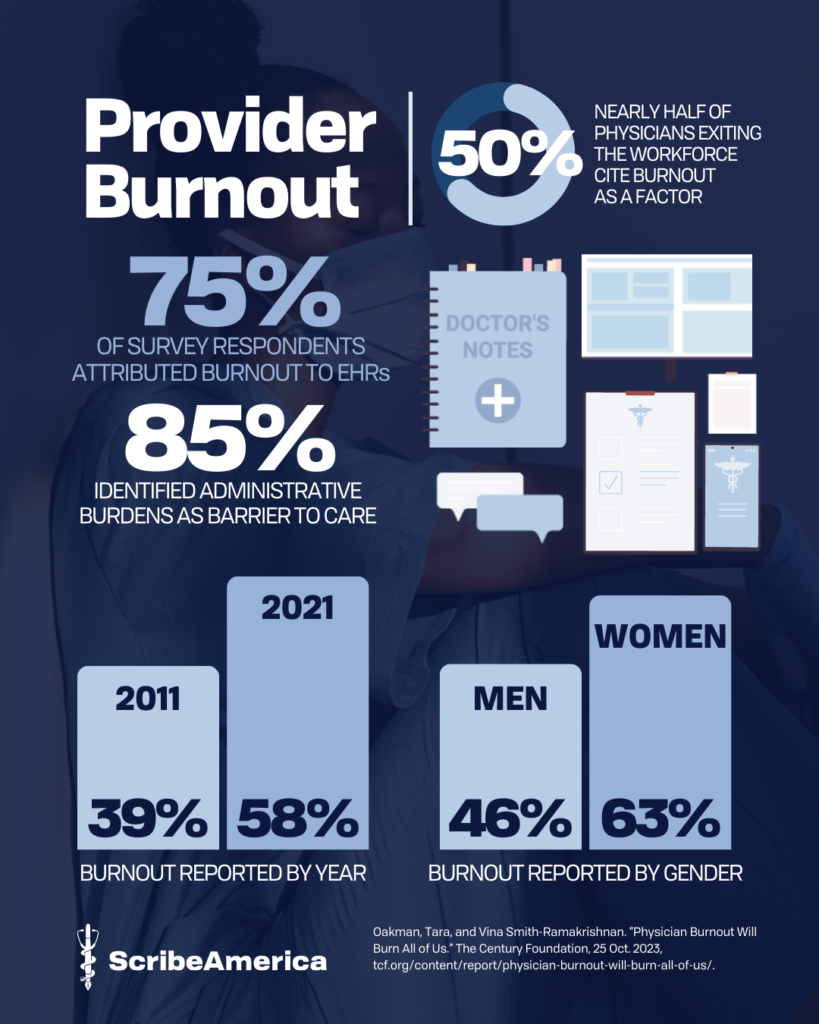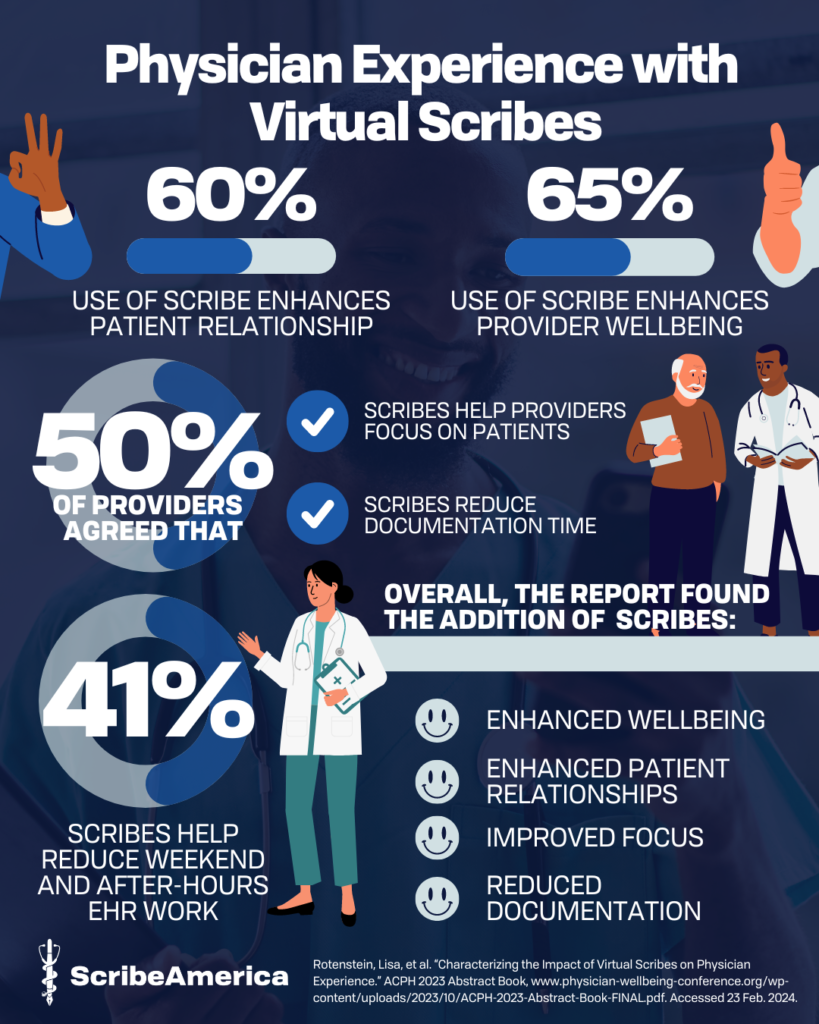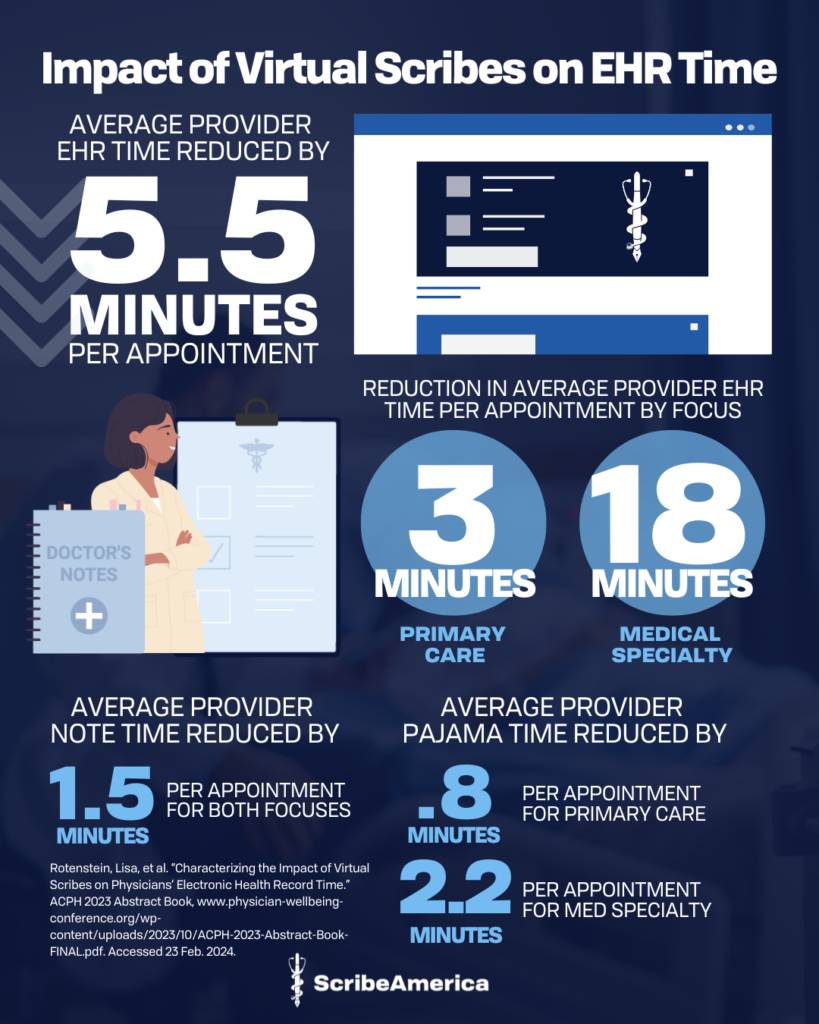Burnout. Fatigue. Poor work-life balance. High turnover. Staffing shortages. These issues have topped lists of provider challenges for years, and they have only been exacerbated by COVID-19. What is the root cause of these issues? Are they systemic? Generational? Multi-faceted? Many organizations are dedicated to finding answers, including the annual American Conference on Physician Health. The ACPH seeks to discuss and explore health systems and infrastructure and how organizations can improve physician well-being. When reviewing 2023’s abstracts, one contributor stood out, striking at the heart of the most common barrier for care teams. Not only did she identify the toll EHRs and documentation take on providers, but she also highlighted medical scribes’ vital role in alleviating that toll.

Lisa Rotenstein, MD, MBA, presented five different abstracts at the 2023 America Conference on Physician Health, and all of them had to do with EHR time as a major contributor to physician burnout and inefficiency. Her research culminated in a few overarching truths; physicians are overwhelmed and the issue is getting worse, high home usage of EHRs resulted in higher burnout and stress, and the addition of medical scribes can alleviate those burdens.
The following abstracts were presented by Rotenstein, along with co-authors Aqsa Mugal, MA, Jianyi Zhang, and Christine Iannaccone, MPH.
Characterizing the Impact of Virtual Scribes on Physician Experience
65% of physicians report that scribes improve their wellbeing
Burnout has been a hot topic for many years, but its prevalence continues to grow. More than half of all US physicians report symptoms of burnout, and the use of screens and electronic health records has been a key factor in fatigue, poor work-life balance, and dissatisfaction. This study, in partnership with Brigham and Women’s Hospital, explored physicians’ perceptions of virtual scribe support to combat these factors.
Rotenstein writes, “Use of virtual scribes is associated with enhanced wellbeing, enhanced patient relationships, and an improved ability to focus on patients during visits.”
60% of surveyed physicians reported that the use of virtual scribes enhanced their relationship with patients. And even more, 65%, said that the use of a virtual scribe improved their own wellbeing. 41% of physicians surveyed noted that the use of scribes even reduced their overtime, minimizing the time that work spilled over into evenings and weekends.

Characterizing the Impact of Virtual Scribes on Physicians’ Electronic Health Record Time
Total average EHR time was reduced by an average of 5.5 minutes per appointment
Physicians take their EHR work home with them so often that there’s a word for it. “Pajama time.” To ameliorate the digital burden, some documentation may be handed off to other staff members, but this is a short-term solution that only shunts the burden onto the shoulders of another. The addition of highly qualified medical scribes, whether in-person, virtual, or supported by AI technology, can massively reduce the impact of EHR documentation and leave the rest of the on-site staff to practice at the top of their license.
The abstract concludes that “…use of virtual scribes is associated with significant decreases in multiple EHR time metrics, and slight increases in note length.” The addition of scribes resulted in less time spent in the EHR with more detailed notes.
In reviewing the metrics from Brigham and Women’s Hospital Epic databases, Rotenstein et. al discovered that the average time spent in the EHR had been reduced by five and a half minutes per appointment. Average note time decreased by more than a minute per appointment, as did pajama time per appointment.

It’s clear that the addition of scribes not only helps physicians feel more productive, but they are more productive. Addressing sources of burnout is a pivotal step for practices to increase patient volume while retaining talent and delivering a healthy, happy work culture. Interested in adding medical scribes to your team? Contact ScribeAmerica to learn more.
References:
Oakman, Tara, and Vina Smith-Ramakrishnan. “Physician Burnout Will Burn All of Us.” The Century Foundation, 25 Oct. 2023, tcf.org/content/report/physician-burnout-will-burn-all-of-us/.
Rotenstein, Lisa, et al. “Characterizing the Impact of Virtual Scribes on Physician Experience.” ACPH 2023 Abstract Book, www.physician-wellbeing-conference.org/wp-content/uploads/2023/10/ACPH-2023-Abstract-Book-FINAL.pdf. Accessed 23 Feb. 2024. Rotenstein, Lisa, et al. “Characterizing the Impact of Virtual Scribes on Physicians’ Electronic Health Record Time.” ACPH 2023 Abstract Book, www.physician-wellbeing-conference.org/wp-content/uploads/2023/10/ACPH-2023-Abstract-Book-FINAL.pdf. Accessed 23 Feb. 2024.
Rotenstein, Lisa, et al. “Characterizing the Impact of Virtual Scribes on Physicians’ Electronic Health Record Time.” ACPH 2023 Abstract Book, www.physician-wellbeing-conference.org/wp-content/uploads/2023/10/ACPH-2023-Abstract-Book-FINAL.pdf. Accessed 23 Feb. 2024.



